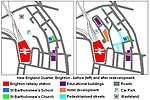St Augustine's Church, Brighton

St Augustine's Church is a former Anglican church in Brighton, part of the English city of Brighton and Hove. It is close to the Preston Park and Round Hill areas in the central northern part of the city. Built in 1896 and extended in 1914, its parish was extended after a nearby church closed, but in 2003 it was declared redundant itself. The building, which is listed at Grade II in view of its architectural importance, for a few years from 2004 the building was leased by the Elim Pentecostal Church. The Pentecostal congregation made free-standing internal changes to create internal spaces which could be heated in winter, but did not touch the fabric of the building. It is now the St Augustine's Community Arts Centre, encompassing a cafe, exhibition space, offices, and other rooms.
Excerpt from the Wikipedia article St Augustine's Church, Brighton (License: CC BY-SA 3.0, Authors, Images).St Augustine's Church, Brighton
Stanford Avenue, Brighton Hollingdean
Geographical coordinates (GPS) Address External links Nearby Places Show on map
Geographical coordinates (GPS)
| Latitude | Longitude |
|---|---|
| N 50.8383 ° | E -0.14 ° |
Address
St Augustine's Centre
Stanford Avenue
BN1 6EA Brighton, Hollingdean
England, United Kingdom
Open on Google Maps











